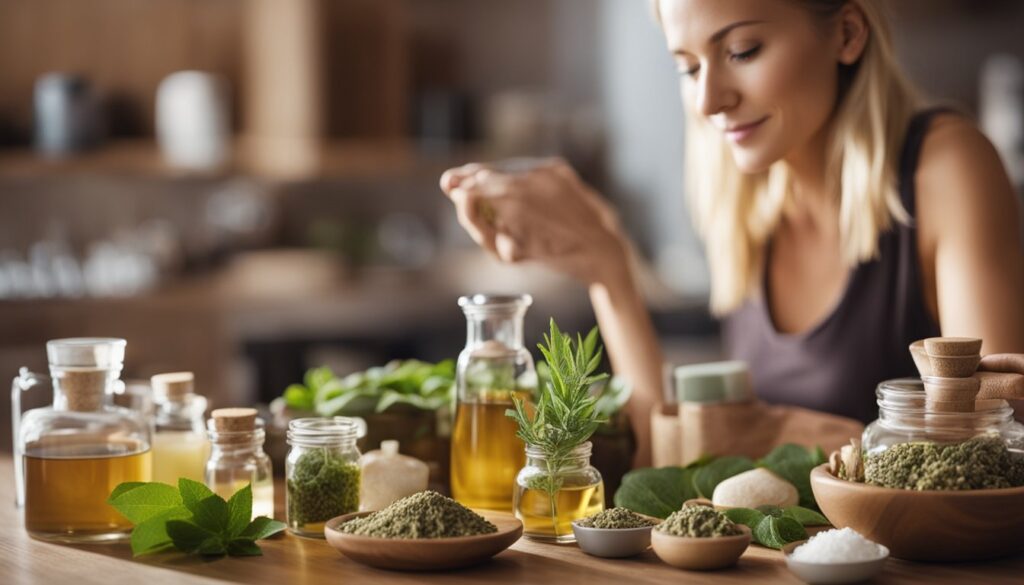Fibrocystic breast disease is a common condition characterized by lumpy, sometimes painful breasts, affecting many women at some point in their lives. Though it’s usually non-cancerous, the discomfort and anxiety it can cause shouldn’t be dismissed. Fortunately, there are natural approaches to prevention that can support breast health and potentially reduce the occurrence of this condition.

Your diet and lifestyle play vital roles in the health of your breast tissue. Incorporating foods that maintain hormonal balance and reducing the intake of stimulants such as caffeine can be beneficial. Moreover, specific dietary changes, like increasing fiber intake, can help control hormonal fluctuations behind fibrocystic breast disease. Embracing these natural strategies may not only ease the symptoms if you already have fibrocystic breasts but could also be proactive measures in prevention.
It can’t be stressed enough that managing stress, maintaining a healthy weight, and regular exercise are pillars of overall well-being and, by extension, breast health. While medical treatment is essential for some, understanding and utilizing a natural approach to fibrocystic breast disease prevention can empower you to take charge of your health, using your body’s inherent strengths.
Understanding Fibrocystic Breast Disease

Fibrocystic breast disease is a common, non-cancerous condition that can cause a variety of changes in your breast tissue. This section explores the defining characteristics and typical symptoms, examines how hormonal fluctuations influence the condition throughout your menstrual cycle, and clarifies how benign fibrocystic changes are distinguished from cancerous conditions.
Characteristics and Symptoms
Your breast tissue might feel lumpy and tender, particularly in the week before your menstrual period. These symptoms are commonly attributed to fibrocystic breasts, a condition characterized by cystic changes and fibrosis—the development of fibrous tissue. You may notice swelling, increased breast discomfort, or sensitivity, which tend to fluctuate with hormone levels. Breast lumps can feel rubbery and nodular, and while often dense, they can also be swollen and heavy.
Hormonal Influences and Menstrual Cycle
Your menstrual cycle has a direct impact on your breasts due to hormonal fluctuations, particularly levels of estrogen and progesterone. The ducts and connective tissue in your breast can swell, leading to discomfort during certain phases of your cycle. Increased estrogen metabolism may contribute to chest wall pain (mastalgia) and the nodularity that is indicative of fibrocystic changes.
Distinguishing Benign from Cancerous Conditions
When you find a lump, distinguishing between fibrocystic changes and breast cancer is imperative. While fibrocystic breasts are marked by non-cancerous changes such as adenosis, fibroadenomas, and general nodularity, a physician can provide a diagnosis through a clinical breast exam, ultrasound, or a breast biopsy if needed. It is essential to be aware of your personal and family history, as some benign conditions can increase the risk of breast cancer. However, most breast lumps associated with fibrocystic changes are benign and do not signify cancer.
Natural Management and Preventive Practices

In addressing fibrocystic breast changes, your focus on natural management and prevention can be pivotal. This involves specific diet and lifestyle alterations, incorporating certain supplements and herbal remedies, and adopting supportive measures for pain relief to potentially ease discomfort and improve breast health.
Diet and Lifestyle Choices
Your daily intake and activities lay the foundation for managing fibrocystic breast changes. A low-fat diet with plenty of vegetables and whole-grain foods can help regulate hormonal fluctuations linked to breast discomfort. Some studies suggest that reducing caffeine consumption from coffee, tea, and chocolate may alleviate symptoms. Regular exercise not only supports overall health but also may reduce hormone-related fluid retention, thus potentially lessening breast pain and nodularity during your reproductive years. Ensuring adequate water intake is also essential for elimination of toxins from the body.
Supplements and Herbal Remedies
Integrating supplements such as vitamin E and essential fatty acids, particularly evening primrose oil and linolenic acid, might be beneficial. They are believed to play a role in reducing inflammation and painful breasts. An iodine deficiency has been linked to fibrocystic breast conditions, making iodine supplements a consideration for some women; however, always seek medical advice before starting any new supplementation.
Supportive Measures for Pain Relief
For immediate pain relief, over-the-counter options like acetaminophen or non-steroidal anti-inflammatory drugs (NSAIDs) such as ibuprofen can be effective. Wearing a supportive bra can reduce discomfort associated with lumpy, uncomfortable breasts. Additionally, applying a heating pad to the affected area or engaging in regular self-exams to become familiar with your normal breast tissue may provide comfort and promote early detection of any notable changes. It is important to note that while some therapies such as tamoxifen and danazol, or hormone replacement therapy, have been used in treatment, these are not considered natural approaches and should be discussed with a healthcare professional.
Frequently Asked Questions

In this section, we provide answers to common queries about natural approaches to fibrocystic breast disease, shedding light on how you can manage symptoms and possibly prevent the condition through natural remedies, nutrition, and lifestyle choices.
What natural remedies can help manage symptoms of fibrocystic breast disease?
Certain natural diuretics, like parsley, cucumbers, and cabbage, may assist in reducing breast swelling and tenderness. These foods help flush your body, potentially soothing fibrocystic breast symptoms.
Which vitamins and supplements are beneficial for reducing discomfort associated with fibrocystic breasts?
Vitamin E and evening primrose oil are among supplements known to help some individuals with fibrocystic breasts. They may alter the balance of fatty acids in cells and reduce pain.
Are there specific dietary changes that can help prevent the development of fibrocystic breast disease?
Incorporating whole-grain foods and a high intake of fiber can aid in controlling hormonal fluctuations that contribute to fibrocystic breast disease. Opt for foods like brown rice, beans, and whole-wheat bread to maintain a balanced diet.
Can exercise and lifestyle modifications contribute to alleviating fibrocystic breast symptoms?
Regular exercise can improve blood flow and reduce hormonal imbalances, which may help alleviate the discomfort caused by fibrocystic breasts. In addition, reducing caffeine and fat intake and avoiding tight-fitting clothing can also contribute to symptom relief.
How does hormonal balance impact fibrocystic breast disease, and what natural approaches regulate hormones?
Hormonal balance plays a crucial role in the development of fibrocystic breast disease. Managing stress, getting enough sleep, and maintaining a healthy weight through a balanced diet and regular exercise are all natural ways to help regulate your hormones.
What are the common misconceptions about fibrocystic breast disease that might affect prevention strategies?
A common misconception is that all breast lumps are indicative of cancer, yet fibrocystic breast changes typically represent benign conditions. Understanding that fibrocystic breast disease is most often noncancerous can alleviate unfounded worries and help focus on preventive care.